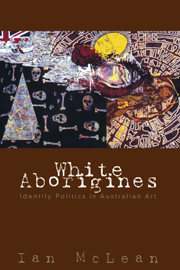Book contents
- Frontmatter
- Contents
- List of Illustrations
- Preface
- Acknowledgments
- 1 Ocean and the Antipodes
- 2 Artful Killings
- 3 The Art of Settlement
- 4 The Bad Conscience of Impressionism
- 5 Aboriginalism and Australian Nationalism
- 6 The Aboriginal Renaissance
- 7 Aboriginality and Contemporary Australian Painting
- 8 Painting for a New Republic
- Postscript: The Wandering Islands
- Notes
- Bibliography
- Index
6 - The Aboriginal Renaissance
Published online by Cambridge University Press: 05 August 2012
- Frontmatter
- Contents
- List of Illustrations
- Preface
- Acknowledgments
- 1 Ocean and the Antipodes
- 2 Artful Killings
- 3 The Art of Settlement
- 4 The Bad Conscience of Impressionism
- 5 Aboriginalism and Australian Nationalism
- 6 The Aboriginal Renaissance
- 7 Aboriginality and Contemporary Australian Painting
- 8 Painting for a New Republic
- Postscript: The Wandering Islands
- Notes
- Bibliography
- Index
Summary
If during the 1960s and 1970s the Australian art scene changed dramatically for both Aboriginal and non-Aboriginal artists, these changes appeared to be quite independent of each other. Not until the 1980s did they begin to converge. This chapter considers the development of Aboriginal art since the 1960s and then discusses its impact on non-Aboriginal Australian art since that time.
Aboriginal Art since 1960
The grip of Aboriginalism on the reception of Aboriginality not only loosened but virtually disappeared in the 1960s. Coincident with this was the tragic death of the Aranda artist Albert Namatjira – tragic because his achievements were also his undoing. Within a decade, and with no training in Western art practices, Namatjira had risen from obscurity and extreme underprivilege to being one of Australia's most famous artists and citizens. This, combined with his subsequent death at the hands of larger forces, gave his life and art mythical proportions which profoundly affected Aboriginal and non-Aboriginal Australians.
The reception of Namatjira's art by the Australian academic and professional community during his lifetime was primarily concerned with its perceived aesthetic value within the context of Eurocentric traditions. Aborigines however, were generally moved by the political import of his art. Indeed, they claim him as the progenitor of the Aboriginal art movement. The Koori artist Lin Onus observed that the embryonic urban Aboriginal art movement which emerged in the late 1960s and 1970s was largely ‘inspired by the success of the famed Arrernte artist Albert Namatjira in the 1950s.’
- Type
- Chapter
- Information
- White AboriginesIdentity Politics in Australian Art, pp. 98 - 119Publisher: Cambridge University PressPrint publication year: 1998

